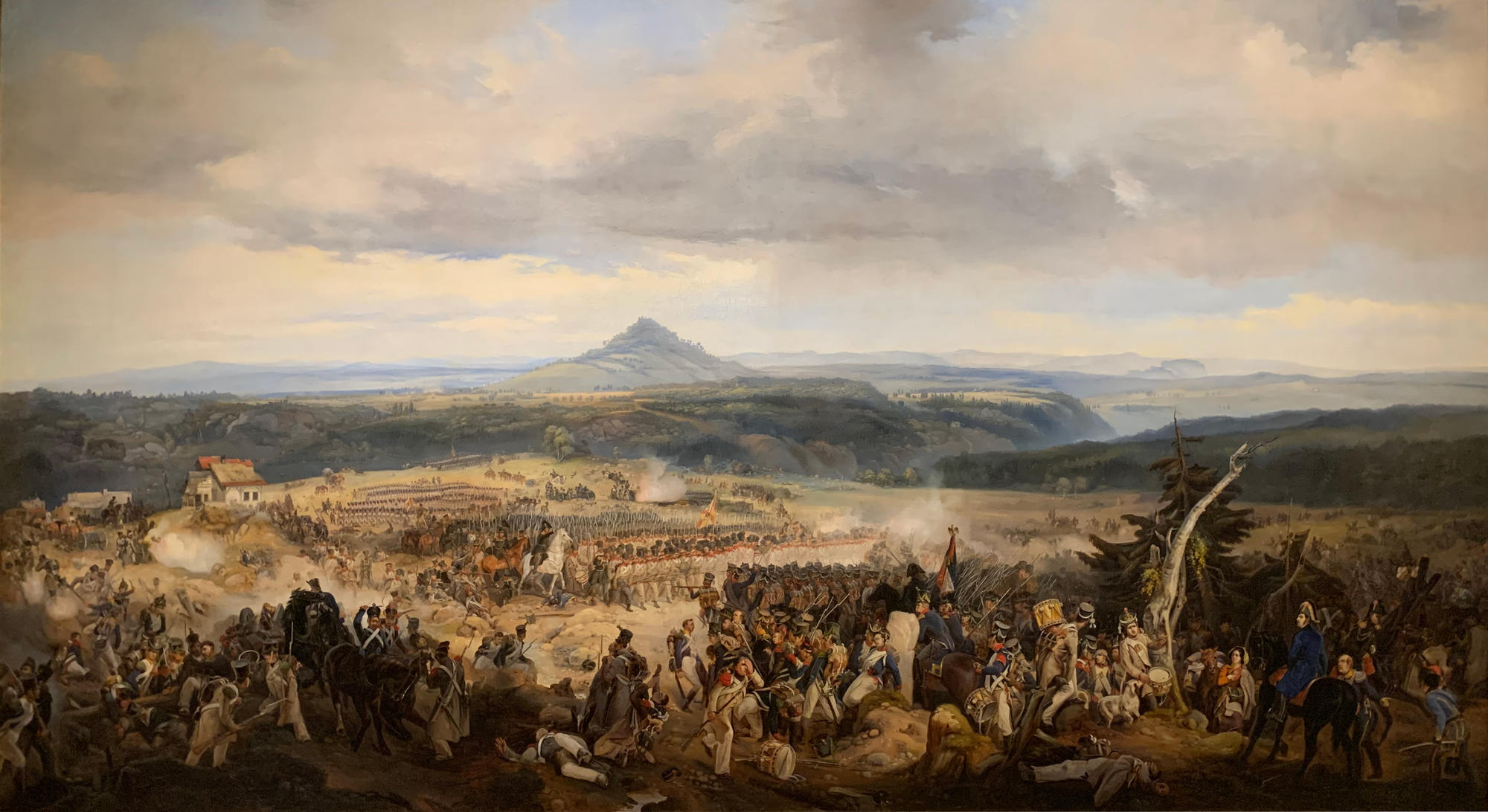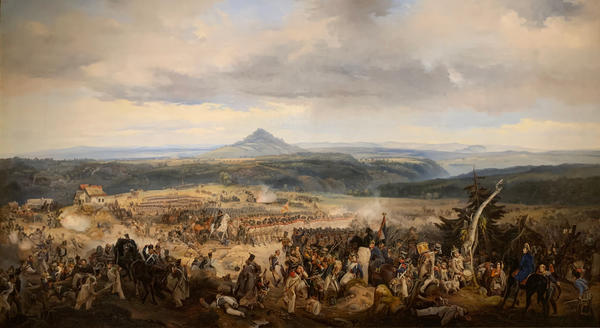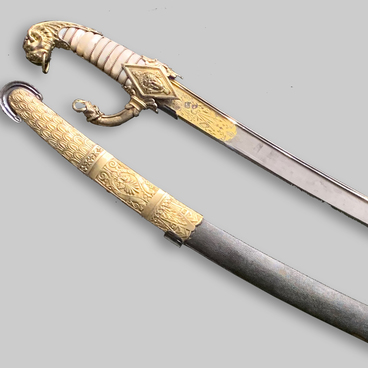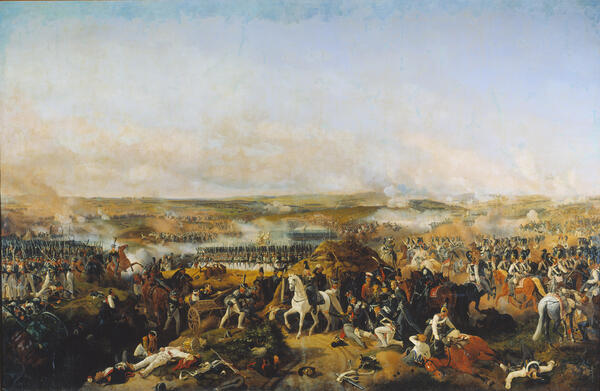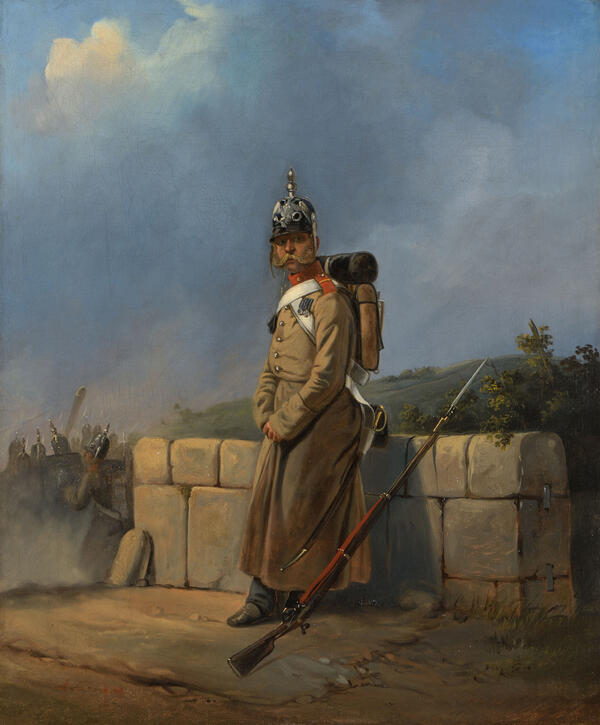The picture is a small copy of the canvas of the same name painted by Alexander Ivanovich Sauerweid (1783–1844), which was completed by Bogdan Pavlovich Willewalde (1818–1903) in 1848. It was stored in the Winter Palace and was exhibited in the Piquet Hall.
The plot of the picture is based on the episode when the guard regiments (Preobrazhensky and Semyonovsky) passed through the ranks of the French soldiers. The battle took place near Kulm, not far from Gisguebel. With their bayonets, the warriors broke the way for themselves, as well as for the corps of Ostermann-Tolstoy who later took up a position near the town of Kulm.
On the canvas, the artist depicted an episode from one of the overseas campaigns that occurred in 1813.
Initially, the canvas belonged to the collection of the Military History Museum (1930), and then it was handed over to the collection of the Museum of the Life Guards of the Preobrazhensky Regiment. In 1851, it was gifted to the Regiment by the Royal Heir, Prince Alexander Nikolayevich, which is confirmed by the inscription ‘Schwabe 1851’ in the lower left corner and the text ‘The Battle of Gisguebel on August 16, 1813. Granted to L.G. Preobrazhensky Regiment of His Imperial Majesty the Sovereign Heir the Great Prince Alexander Nikolayevich in 1851’ on the original frame (lower level).
The Russian army undertook overseas campaigns in 1813-1814, which were nothing more than military battles of troops in Europe, with the assistance of the Allies. Most contemporaries believed that they were a continuation of the Patriotic War of 1812 a retaliation for all the misfortunes that fell on Russia due to the ‘twenty languages’ invasion.
For ideological justification, they used a slogan calling for the liberation of European countries from Napoleonic invaders. Emperor Alexander I was the leader of the troops and an ardent opponent of Napoleon. He called to fight and made every effort to create the sixth anti-French coalition.
Soon, when Prussia joined the coalition, followed suit by Sweden and Austria, Western Europe became an ally to Russia. By the end of 1813, the former Napoleonic satellites (Bavaria and Württemberg) came down to the Russian side.
First, Poland was chosen as the main venue for hostilities, but then the battles moved to German territory. There, Napoleon experienced a blow in 1813, having lost in the famous Battle of the Peoples near Leipzig.
The allies entered France in 1814 and conquered Paris, which forced Napoleon to abdicate. After that, he was exiled to the island of Elba.
The plot of the picture is based on the episode when the guard regiments (Preobrazhensky and Semyonovsky) passed through the ranks of the French soldiers. The battle took place near Kulm, not far from Gisguebel. With their bayonets, the warriors broke the way for themselves, as well as for the corps of Ostermann-Tolstoy who later took up a position near the town of Kulm.
On the canvas, the artist depicted an episode from one of the overseas campaigns that occurred in 1813.
Initially, the canvas belonged to the collection of the Military History Museum (1930), and then it was handed over to the collection of the Museum of the Life Guards of the Preobrazhensky Regiment. In 1851, it was gifted to the Regiment by the Royal Heir, Prince Alexander Nikolayevich, which is confirmed by the inscription ‘Schwabe 1851’ in the lower left corner and the text ‘The Battle of Gisguebel on August 16, 1813. Granted to L.G. Preobrazhensky Regiment of His Imperial Majesty the Sovereign Heir the Great Prince Alexander Nikolayevich in 1851’ on the original frame (lower level).
The Russian army undertook overseas campaigns in 1813-1814, which were nothing more than military battles of troops in Europe, with the assistance of the Allies. Most contemporaries believed that they were a continuation of the Patriotic War of 1812 a retaliation for all the misfortunes that fell on Russia due to the ‘twenty languages’ invasion.
For ideological justification, they used a slogan calling for the liberation of European countries from Napoleonic invaders. Emperor Alexander I was the leader of the troops and an ardent opponent of Napoleon. He called to fight and made every effort to create the sixth anti-French coalition.
Soon, when Prussia joined the coalition, followed suit by Sweden and Austria, Western Europe became an ally to Russia. By the end of 1813, the former Napoleonic satellites (Bavaria and Württemberg) came down to the Russian side.
First, Poland was chosen as the main venue for hostilities, but then the battles moved to German territory. There, Napoleon experienced a blow in 1813, having lost in the famous Battle of the Peoples near Leipzig.
The allies entered France in 1814 and conquered Paris, which forced Napoleon to abdicate. After that, he was exiled to the island of Elba.
